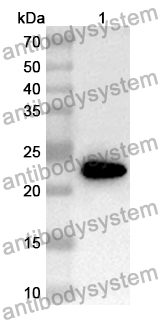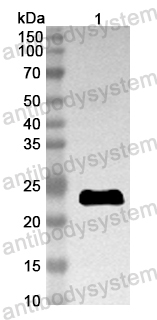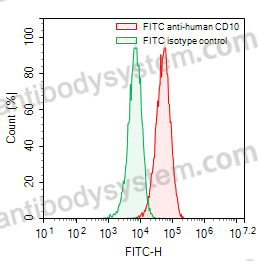Catalog No.
PHJ81302
Species reactivity
Human
Host species
Rabbit
Isotype
IgG
Clonality
Polyclonal
Immunogen
E. coli - derived recombinant Human COL17A1 (Pro184-Thr301).
Tested applications
ELISA: 1:4000-1:8000, IHC: 1:50-1:100, WB: 1:1000-1:4000
Target
Linear IgA disease antigen 1, COL17A1, 180 kDa bullous pemphigoid antigen 2, LAD-1, Linear IgA bullous disease antigen of 97 kDa, 120 kDa linear IgA dermatosis antigen, 97-LAD, Collagen alpha-1(XVII) chain, Bullous pemphigoid antigen 2, 97 kDa linear IgA bullous dermatosis antigen, LABD97, 97 kDa LAD antigen, BPAG2, BP180
Purification
Purified by antigen affinity column.
Accession
Q9UMD9
Applications
ELISA, IHC, WB
Form
Liquid
Storage buffer
0.01M PBS, pH 7.4, 50% Glycerol, 0.05% Proclin 300.
Stability and Storage
Use a manual defrost freezer and avoid repeated freeze thaw cycles. Store at 2 to 8°C for frequent use. Store at -20 to -80°C for twelve months from the date of receipt.
Native Autoantigen Complex Detects Pemphigoid Autoantibodies., PMID:36992950
Absence of NC14A Domain of COLXVII/BP180 in Mice Results in IL-17‒Associated Skin Inflammation., PMID:35985497
The CD44/COL17A1 pathway promotes the formation of multilayered, transformed epithelia., PMID:34087104
Small molecule Y-320 stimulates ribosome biogenesis, protein synthesis, and aminoglycoside-induced premature termination codon readthrough., PMID:33939688
Identification of a Novel COL17A1 Compound Heterozygous Mutation in a Chinese Girl with Non-Herlitz Junctional Epidermolysis Bullosa., PMID:32862392
Tetraspanin CD151 and integrin α3β1 contribute to the stabilization of integrin α6β4-containing cell-matrix adhesions., PMID:31488507
Life before and beyond blistering: The role of collagen XVII in epidermal physiology., PMID:29604146
New versatile monoclonal antibodies against type XVII collagen endodomain for diagnosis and subtyping COL17A1-associated junctional epidermolysis bullosa., PMID:26334130
Dermal eosinophilic infiltrate in junctional epidermolysis bullosa., PMID:25950805
Collagen XVII is expressed in malignant but not in benign melanocytic tumors and it can mediate antibody induced melanoma apoptosis., PMID:22688676
Junctional epidermolysis bullosa of late onset explained by mutations in COL17A1., PMID:21466533
Bullous pemphigoid in a patient with suspected non-Herlitz junctional epidermolysis bullosa., PMID:20456391
Localized and generalized forms of blistering in junctional epidermolysis bullosa due to COL17A1 mutations in the Netherlands., PMID:17263807
Eosinophil infiltration in three patients with generalized atrophic benign epidermolysis bullosa from a Japanese family: molecular genetic and immunohistochemical studies., PMID:16172808
A novel homozygous point mutation in the COL17A1 gene in a Chinese family with generalized atrophic benign epidermolysis bullosa., PMID:11912005
Deletion of the cytoplasmatic domain of BP180/collagen XVII causes a phenotype with predominant features of epidermolysis bullosa simplex., PMID:11851893
Truncated typeXVII collagen expression in a patient with non-herlitz junctional epidermolysis bullosa caused by a homozygous splice-site mutation., PMID:11406649
The 97 kDa linear IgA bullous dermatosis antigen is not expressed in a patient with generalized atrophic benign epidermolysis bullosa with a novel homozygous G258X mutation in COL17A1., PMID:9804354
Two forms of collagen XVII in keratinocytes. A full-length transmembrane protein and a soluble ectodomain., PMID:9748270
Cloning of the human type XVII collagen gene (COL17A1), and detection of novel mutations in generalized atrophic benign epidermolysis bullosa., PMID:9012408
Generalized atrophic benign epidermolysis bullosa., PMID:9551142
Compound heterozygosity for a dominant glycine substitution and a recessive internal duplication mutation in the type XVII collagen gene results in junctional epidermolysis bullosa and abnormal dentition., PMID:8669466




